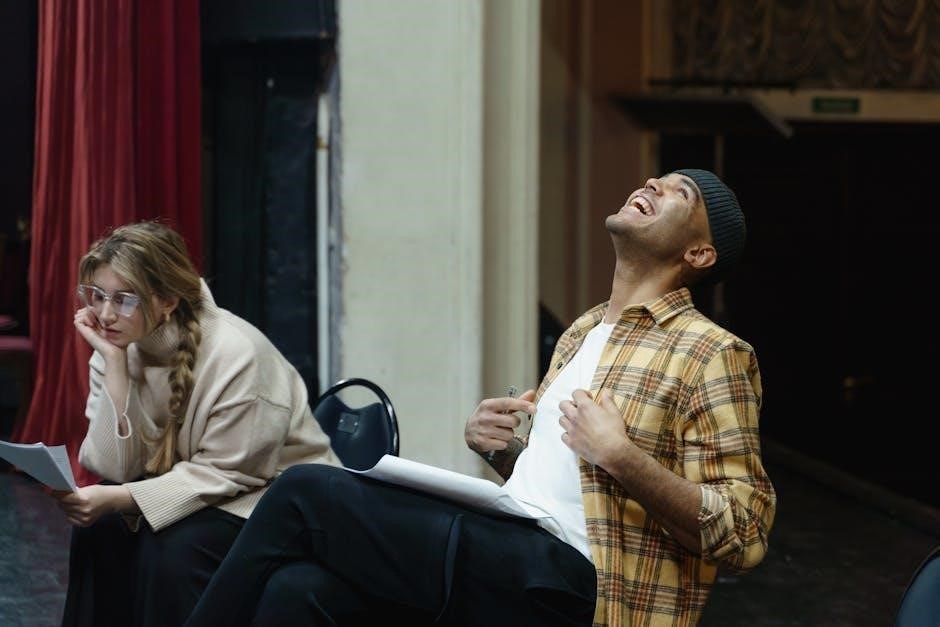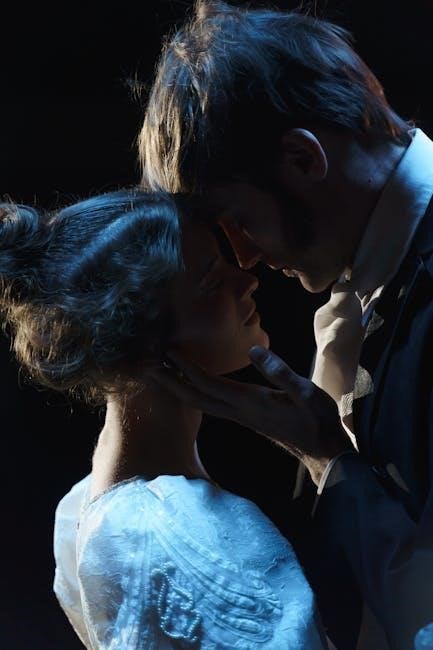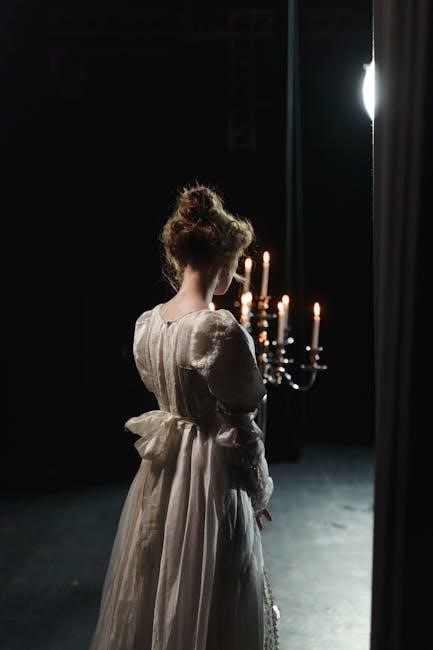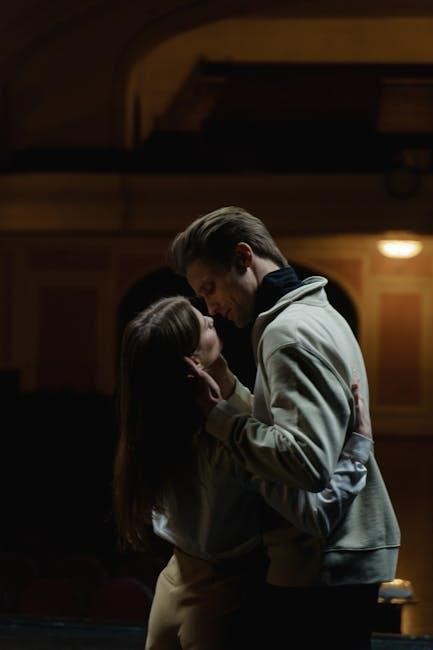The Crucible Act 1 sets the stage in Salem, Massachusetts, introducing the initial conflict with Betty’s mysterious illness and the seeds of hysteria and accusation.
Setting the Stage in Salem, Massachusetts
Act 1 of The Crucible unfolds in Salem, Massachusetts, a Puritan community governed by strict religious and moral codes. The opening scene takes place in Reverend Parris’s household, where the oppressive atmosphere of fear and suspicion is palpable. Parris’s daughter, Betty, lies unresponsive in bed, sparking panic and whispers of witchcraft. The setting shifts between the claustrophobic bedroom and the mysterious forest, where the unseen scene of the girls dancing and conjuring spirits occurs. Salem’s rigid societal structure and the pervasive fear of the supernatural create a tense backdrop. The community’s reliance on religion and its distrust of outsiders amplify the sense of impending chaos. This setting lays the groundwork for the hysteria and accusations that dominate the play.
The Unseen Scene in the Woods
The unseen scene in the woods serves as a catalyst for the events of Act 1, occurring before the play’s opening. It involves Abigail, Betty, Tituba, and other girls dancing and conjuring spirits, actions deemed sinful in Salem’s rigid society. This secret gathering sparks fear and suspicion, setting off a chain reaction of accusations. The scene highlights the girls’ rebellion against societal norms and their vulnerability to accusations of witchcraft. It also introduces the theme of mass hysteria, as the community’s fear of the unknown begins to escalate. The woods symbolize a space outside societal control, where forbidden behaviors unfold, ultimately leading to the chaos that dominates the play. This unseen event is crucial in understanding the motivations and fears that drive the characters.

Plot Summary of Act 1
The opening act introduces Betty’s unexplained illness, the discovery of the girls dancing in the forest, and Abigail’s accusations, setting off a chain of hysteria and accusation, while Proctor confronts Parris over his mercenary concerns.
The Bedroom Scene: Reverend Parris and Betty
The bedroom scene opens in Reverend Parris’s house, where his daughter Betty lies unresponsive in bed. Parris, deeply concerned and praying fervently, reveals his fear of witchcraft tarnishing his reputation. Abigail, his niece, enters the room, followed by Susanna Walcott, who suggests calling a doctor. Parris hesitates, fearing accusations of witchcraft, showcasing his self-interest. The tension escalates as Abigail’s presence hints at underlying conflicts, including her rumored affair with John Proctor. This scene establishes the eerie atmosphere and introduces the fear driving the plot, while highlighting Parris’s priorities and the suppressed truths within the family.
The Forest Scene: Dancing and Conjuring Spirits
In the unseen forest scene, Betty, Abigail, Tituba, and other girls gather secretly to dance and conjure spirits, a rebellious act against Salem’s strict norms. This moment, though not directly shown, is described in Act 1, highlighting the girls’ defiance and the supernatural fears it sparks. Abigail’s ambition and Tituba’s influence are central, as they attempt to communicate with spirits, leading to Betty’s trance-like state. The scene fuels suspicion and hysteria, as the community reacts with fear, setting the stage for accusations. This pivotal moment showcases how youthful rebellion and superstition ignite the chaos that unfolds, emphasizing the destructive power of unchecked emotions and societal fears in Salem.
The Conflict Between Parris and Proctor
The tension between Reverend Parris and John Proctor emerges early in Act 1, stemming from Parris’s suspicion of Proctor’s disapproval of his ministry. Parris, driven by self-interest, accuses Proctor of questioning his authority, while Proctor criticizes Parris for focusing on material gain over spiritual guidance. Their conflict reflects deeper societal divisions in Salem, as Proctor’s moral integrity clashes with Parris’s fear of losing reputation and power. This encounter highlights the underlying mistrust and hostility that will escalate as the witch trials unfold, foreshadowing the destructive consequences of their animosity.
Act 1 introduces key characters: Reverend Parris, a selfish minister; Abigail Williams, his ambitious niece; Tituba, the enslaved woman with secrets; and John Proctor, a moral yet flawed farmer.
Reverend Samuel Parris: A Selfish Minister
Reverend Samuel Parris is portrayed as a self-centered and manipulative figure in Act 1 of The Crucible. His primary concern is his reputation and social standing, rather than the well-being of his family or community. Parris is deeply worried about the potential scandal involving his daughter Betty’s mysterious illness and his niece Abigail’s involvement in witchcraft. He is more focused on protecting his name and position than addressing the underlying issues. His selfishness is evident when he prioritizes his own interests over the truth, showcasing his moral ambiguity. Parris’s actions in the bedroom scene highlight his hypocrisy, as he prays for Betty’s recovery while harboring fears of losing his status in Salem. His character serves as a catalyst for the unfolding hysteria, revealing the destructive power of self-interest and fear.
Abigail Williams: The Ambitious Niece
Abigail Williams, the niece of Reverend Parris, emerges as a central figure in Act 1, driven by ambition and a desire for power. Her past as John Proctor’s former servant and lover fuels her resentment and jealousy. Abigail’s admission of conjuring spirits with Tituba and Betty reveals her willingness to defy societal norms, showcasing her manipulative nature. Her fear of being exposed as an adulteress and her desire to replace Elizabeth Proctor as John’s wife motivate her actions. Abigail’s ambition and cunning are evident as she begins to manipulate others, setting the stage for the chaos that unfolds. Her character represents the destructive force of unchecked ambition and the dangers of deception in a rigid societal framework.
Tituba: The Slave with a Secret
Tituuba, a slave from Barbados, serves in Reverend Parris’s household, bringing cultural and spiritual practices unfamiliar to the Puritan community. Her involvement in the forest ritual, where she conjures spirits, sparks fear and suspicion. As an outsider, Tituuba becomes a target for accusations, highlighting the racial and social tensions of Salem. Her knowledge of supernatural practices, though born from her cultural background, is misinterpreted as witchcraft, making her a pivotal figure in the unfolding hysteria. Tituuba’s character represents the intersection of cultural differences and the fear of the unknown, which fuels the witch trials. Her role in Act 1 underscores the destructive power of prejudice and misinformation.
John Proctor: The Moral yet Flawed Farmer
John Proctor emerges as a complex character in Act 1, portrayed as a moral yet flawed individual. His affair with Abigail Williams underscores his imperfections, while his sense of responsibility and honesty highlight his moral fiber.
Proctor’s internal conflict is evident as he grapples with guilt over his infidelity. His self-hatred and desire to redeem himself reveal a man struggling to reconcile his past mistakes with his current values.
Despite his flaws, Proctor’s commitment to truth and integrity sets him apart in a community consumed by hysteria. His disdain for Reverend Parris and his refusal to tolerate hypocrisy further emphasize his moral grounding.
Proctor’s character serves as a foil to the moral decay surrounding him, making him a tragic figure whose flaws ultimately contribute to his downfall.
Themes in Act 1 include mass hysteria, fear of witchcraft, and the destructive power of unchecked accusations, highlighting the societal tensions and moral corruption in Salem.

Mass Hysteria and Self-Preservation
Act 1 of The Crucible introduces the theme of mass hysteria and self-preservation, as fear and panic spread throughout Salem. The mysterious illness of Betty Parris and the whispered accusations of witchcraft create an atmosphere of dread. Reverend Parris, fearing damage to his reputation, urges the community to uncover the truth, unaware of the chaos he unleashes. The girls’ actions in the forest, particularly their dancing and spirit conjuring, ignite suspicion, leading to a wave of accusations. Abigail Williams, driven by her own secrets and ambitions, manipulates the situation to protect herself, setting off a chain reaction of fear and self-preservation. This act masterfully portrays how quickly hysteria can escalate, blurring the lines between truth and deception.
Reputation and Social Fear
In Act 1 of The Crucible, reputation emerges as a central theme, driving characters’ actions and decisions. Reverend Parris is deeply concerned about his family’s reputation due to Betty’s mysterious illness, fearing it may be linked to witchcraft. Similarly, Abigail’s past adultery with John Proctor haunts her, and she seeks to protect her reputation by shifting blame onto others. The fear of social condemnation pushes characters like Parris and Abigail to prioritize appearances over truth, fueling the growing hysteria. This theme highlights how the fear of reputational damage can lead individuals to make morally compromising choices, contributing to the play’s exploration of human frailty and societal pressure.
Deception and Hidden Sins
Deception and hidden sins are central themes in Act 1 of The Crucible. The act reveals the secret affair between John Proctor and Abigail Williams, which creates tension and moral conflict. Abigail’s ambition and desire for power drive her to manipulate situations to her advantage, while Proctor struggles with guilt over his past transgression. The unseen forest scene, where the girls dance and conjure spirits, showcases their hidden rebellion and fear of being exposed. These secrets escalate the hysteria, as accusations of witchcraft become a tool for individuals to hide their own sins. The act highlights how deception can unravel reputations and lead to destructive consequences.

Historical Context of The Crucible
The Salem Witch Trials of 1692
The play is set during the Salem witch trials, a dark period in American history marked by mass hysteria, fear, and false accusations of witchcraft.
The Salem Witch Trials of 1692 were a series of trials and executions in colonial Massachusetts, fueled by mass hysteria and fear of witchcraft. Arthur Miller’s The Crucible is loosely based on these events, using them as a backdrop to explore themes of paranoia, intolerance, and the dangers of unchecked power. The trials began with accusations of witchcraft against local women, often driven by personal vendettas or superstition. The lack of due process and the reliance on questionable evidence led to the execution of 20 people, most by hanging. The trials are widely regarded as a dark chapter in American history, highlighting the destructive potential of fear and false accusations. Miller’s play captures the essence of this period, emphasizing its relevance to broader societal issues.

Significance of Act 1 in The Crucible
Act 1 lays the foundation for the play, introducing themes of hysteria, reputation, and deception while foreshadowing the devastating consequences of unchecked accusations and fear.
Foreshadowing Destructive Consequences
Act 1 of The Crucible masterfully foreshadows the devastating consequences of unchecked accusations and mass hysteria. The mysterious illness of Betty Parris and the whispered fears of witchcraft create an atmosphere of dread. The unseen forest scene, where the girls conjure spirits, hints at the chaos to come. Reverend Parris’s obsession with his reputation and Abigail’s admission of conjuring spirits plant seeds of suspicion. John Proctor’s past affair with Abigail and his moral struggle foreshadow his eventual downfall. Miller’s use of these elements predicts the escalating hysteria and the destructive power of unchecked accusations, setting the stage for tragedy. The act underscores how fear and deception can unravel a community, leading to irreversible and catastrophic outcomes.

